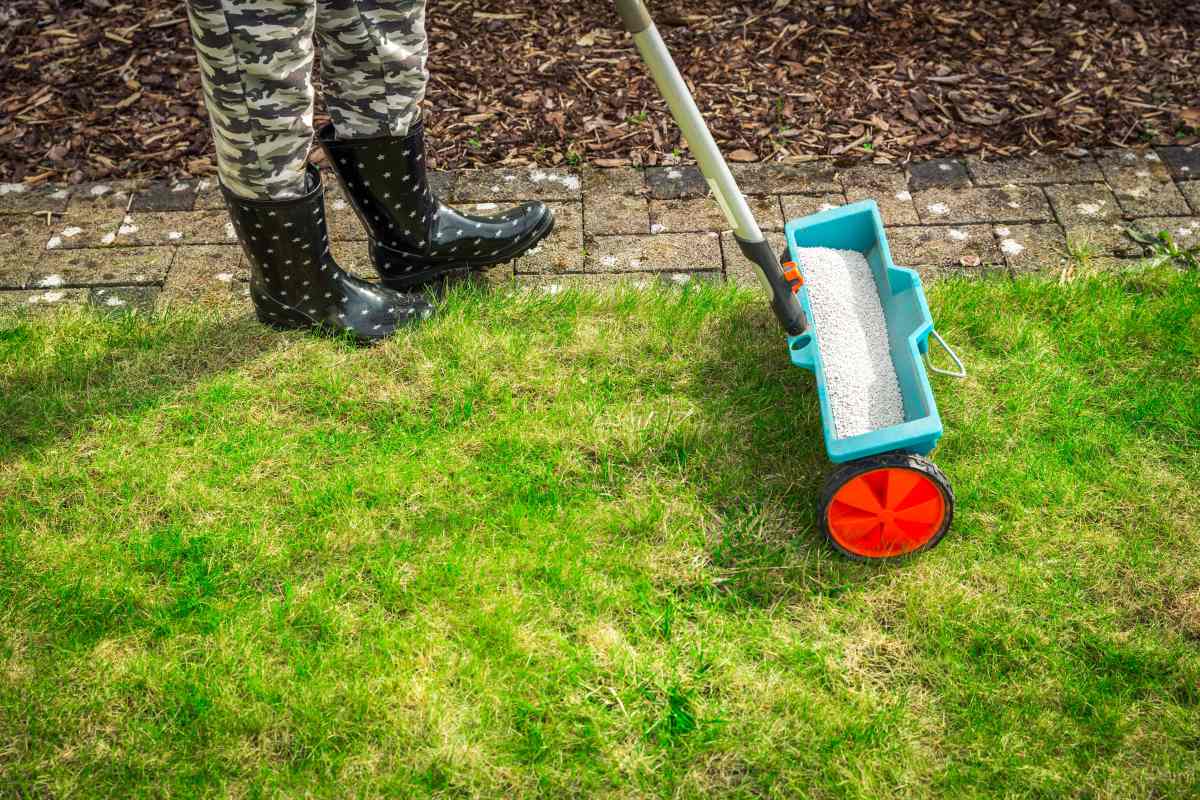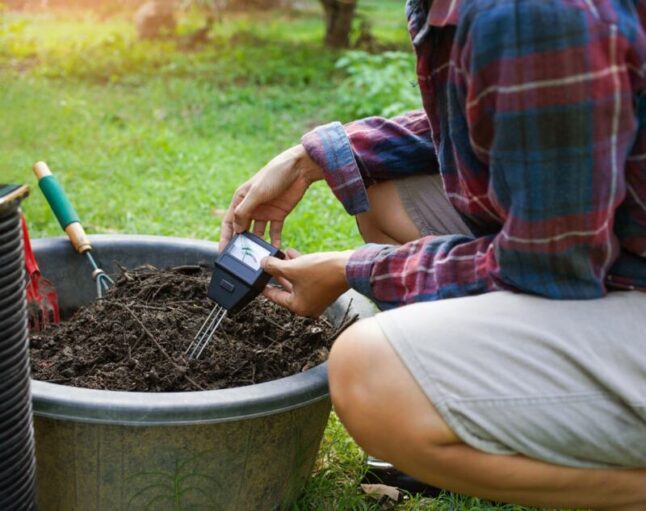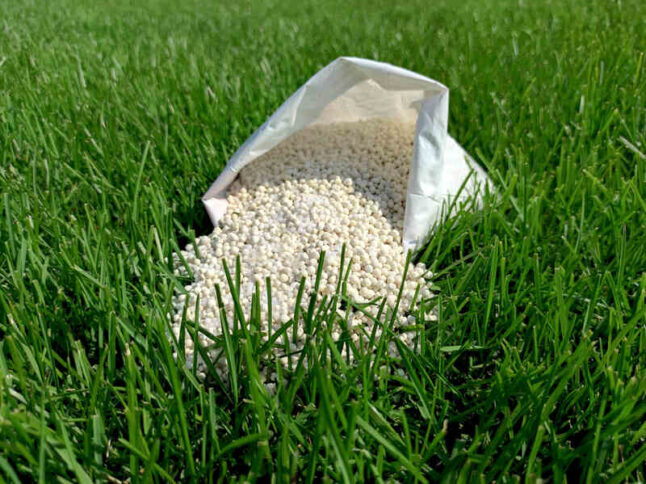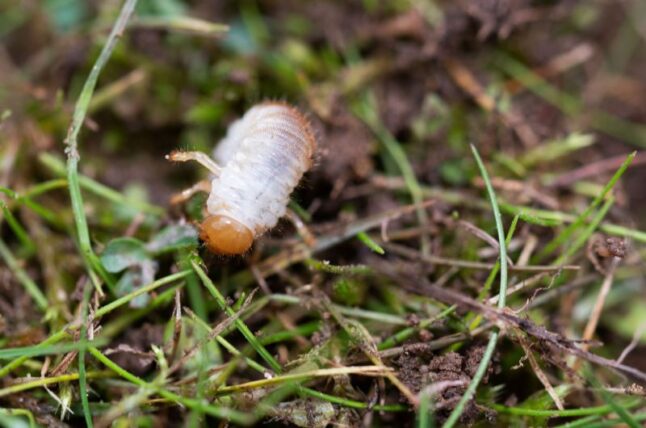
Fertilization is a key component to a successful lawn in Kentucky. However, knowing when and how to fertilize your lawn is essential. Improper fertilization can hurt your grass rather than help it. This guide will walk you through everything you need to know about Kentucky lawn fertilization, including DIY and professional options.
Not interested in a DIY approach? Jump straight to our Kentucky lawn care pros page, where you can choose a reliable local pro to fertilize your Kentucky lawn.
How to Fertilize Your Kentucky Lawn in 8 Steps
Fertilizing a lawn in Kentucky takes know-how and planning, but it isn’t difficult once you know what you’re doing! Follow these steps for the best DIY lawn fertilization method:
1. Identify the Grass Type in Your Lawn
Lawns in Kentucky usually consist of both cool-season grasses and warm-season grasses. First of all, it is most important to determine which type is in your lawn because fertilization patterns and needs for both types of grass are different.
You can also have a look at our guide to the best grass seed in Kentucky to learn more about each grass type, how to identify them, and their maintenance requirements.
When and How to Fertilize Warm-season Grass
Warm-season grasses, such as Zoysia and Bermuda, grow most actively in late spring and early summer.
If you want a lush, green, warm-season lawn, you need plenty of nitrogen (N) in your fertilizer to promote the growth of your grass. Mid spring through summer is the best time to apply fertilizer to your warm-season lawn, as this is the time when your grass starts to green up after coming out of winter dormancy.
Your fertilization schedule for warm-season grass should look like this:
- 1 application in early spring: When the grass greens up after winter; usually late March or April throughout the state of Kentucky
- 1 application in early summer: When grass growth speeds up but before the onset of intense midsummer heat, usually early June in all regions of Kentucky
- 1 application in early fall: At least 6 – 8 weeks before the first expected frost, usually sometime in September (although the first frost can be as early as October for the Louisville and Lexington areas, so plan accordingly)
As the temperature starts to become hotter, reduce the amount of nitrogen you’re adding to the soil to maintain a healthy level of growth. Excessive nitrogen during the hot and dry summer months can stress your grass, making it more vulnerable to drought and diseases.
Apply a fertilizer with an NPK ratio of 15-5-10 or comparable slow-release fertilizer (learn more about how to choose the right fertilizer below). The grass receives consistent nourishment from slow-release fertilizers since the nutrients are released over time.
Slow-release fertilizer helps keep nutrients in the soil and prevents them from washing away during hot and dry periods. It also aids in maintaining the color and vitality of your lawn throughout the summer while limiting overgrowth.
When and How to Fertilize Cool-season Grass
Cool-season grasses, like the Bluegrass state’s namesake Kentucky bluegrass and tall fescue, grow most actively in spring and fall. The best time to apply fertilizer to your cool-season grass is during these active growth periods.
Here’s what your lawn fertilization schedule for cool-season grass should look like:
- 1 application in early spring: When the grass greens up after winter; usually late March or April throughout the state of Kentucky
- 1 application in late summer/early fall: The beginning of the second active growth season; usually early September across Kentucky
- 1 application in late fall: At least 6 weeks before the first expected frost in your area, usually sometime in October
In order to encourage root system growth and resistance during the colder months, the fertilizer ratio should be adjusted. Apply fertilizer in early fall with a formulation with lower nitrogen content and slightly higher phosphorus (P) and potassium (K) content. It encourages deeper root development and better winter resilience in the lawn.
2. Conduct a Soil Test

The right soil is the most important thing for your lawn to flourish. If the soil is healthy, it will be nutritious for your turf, but if your soil lacks some nutrients, then it will lead to a dull, dry lawn. To know the condition of your soil, conduct a soil test.
With the results of a soil test in hand, you’ll be able to make informed decisions about fertilizer and other soil amendments for your lawn. Periodically conduct soil tests to assess the nutrient levels and pH of your soil. Soil tests provide valuable information about your lawn’s nutrient requirements and help you determine the appropriate fertilizer application rates.
Here are two options to assess soil conditions through soil testing in Kentucky:
- Buy a soil testing kit from a regular garden store and assess your soil at home.
- Locate reliable soil testing labs in the state of Kentucky. You can find private laboratories specializing in agricultural or turfgrass testing, or you can visit the University of Kentucky cooperative extension office near you. You can get everything you need to take soil samples and submit them to these laboratories.
After you send in your soil samples, the lab will analyze them and give you a full report on the soil’s condition. This report will include information on nutrient levels (nitrogen, phosphorus, potassium, and others) and soil pH. Use this information to adjust your fertilization program accordingly.
3. Determine the Nutrient Requirements of Your Lawn
After completing a soil test and learning about your grass type, you may move on to figuring out what your lawn needs regarding nutrients. The essential nutrients for a successful lawn include nitrogen, phosphorus, potassium, and a few other micronutrients (including zinc, iron, chlorine, copper, etc.). A deficiency of any of the essential nutrients in your soil may result in poor growth.
Most of the time, your soil does not require micronutrients because they are naturally present in the soil. But you might need to add the main nutrients nitrogen (N), phosphorus (P), and potassium (K). These nutrients are added to the soil in fertilizer.
The amounts of N, P, and K required for healthy growth vary for different grass types. Here are the recommended amounts of nitrogen to be used per year for Kentucky’s most common grasses:
| Grass Type | Application Rate Per Year |
| Bermudagrass | 2-4 pounds of nitrogen per 1,000 sq ft |
| Zoysiagrass | 2-3 pounds of nitrogen per 1,000 sq ft |
| Kentucky bluegrass | 2-4 pounds of nitrogen per 1,000 sq ft |
| Centipedegrass | 1-2 pounds of nitrogen per 1,000 sq ft |
| Tall fescue | 2-3 pounds of nitrogen per 1,000 sq ft |
| Fine fescue | 1-2 pounds of nitrogen per 1,000 sq ft |
| Ryegrass | 2-3 pounds of nitrogen per 1,000 sq ft |
Pro tip: if your soil is acidic, meaning it has a pH higher than 6.5, then you may be advised to add lime to your lawn to neutralize the pH, i.e., decrease acidity to a pH of 6.0 to 6.5.
4. Choose the Appropriate Fertilizer for Your Grass Type

Selecting the best fertilizer involves considering your grass type’s specific nutrient requirements and growth habits. Here are some considerations for choosing the right fertilizer:
- Grass-Specific Formulations: Try to find grass fertilizers labeled explicitly for the season your grass grows in, such as “Warm-Season Grass Fertilizer” or “Cool-Season Grass Fertilizer.” These formulations are designed to meet the nutrient needs of the respective grass types, providing targeted nutrition for optimal growth.
- Slow-Release vs. Quick-Release Fertilizers: Fertilizers that distribute their nutrients slowly and steadily over a long period of time (slow-release) are more effective at preventing nutrient leaching and fostering consistent development. Quick-release fertilizers, on the other hand, provide an immediate nutrient boost but may require more frequent applications.
- Organic vs. Synthetic Fertilizers: Organic fertilizers are derived from natural sources, such as compost, manure, or bone meal. They gradually enhance soil health due to their slow nutrient release. Synthetic fertilizers are chemical-based and offer concentrated forms of nutrients. They may have a rapid effect and provide more precise control over nutrient ratios, but they can damage the soil in the long run.
- Starter Fertilizers: These fertilizers are made to be used on newly planted lawns. Starter fertilizers are primarily high in phosphorus, resulting in healthy root development.
For more detailed information, have a look at our guide to How to Choose the Right Fertilizer for Your Lawn to help you make the right choice.
5. Calculate the Right Amount of Fertilizer
To calculate the exact amount of fertilizer you need to buy, use the formula:
Amount of fertilizer needed = (Desired nitrogen amount / Percentage of nitrogen content in your fertilizer) * 100
For this, you need to know two things:
- The percentage of nutrient content in your fertilizer – fertilizer labels typically include a series of three numbers, such as 10-10-10, that represent the relative amounts of nitrogen (N), phosphorous (P), and potassium (K) in the product (i.e. a fertilizer with a 10-10-10 ratio contains 10% N, 10% P, and 10% K). This is called the NPK ratio.
- The amount of each of the three main nutrients that you want to apply to your lawn in total.
For instance, a 50-pound bag of 10-6-4 fertilizer contains:
5 pounds of actual nitrogen (50 pounds x 0.10 = 5)
3 pounds of phosphate (50 pounds x 0.06 = 3)
2 pounds of potash (K2O) (50 x 0.04 = 2)
The rest of the material in the bag (50 – [5+3+2] = 40 pounds, in our example) is the carrier substance.
If you want to apply 1 pound of nitrogen per 1,000 square feet using the same 10-6-4 fertilizer, the exact amount of fertilizer required would be 10 pounds according to our formula:
(1 pound N / 10% N) * 100 = 10 pounds of fertilizer
This application would also add 0.6 pounds of phosphate and 0.4 pounds of potassium to your lawn.
If you find it difficult to calculate the amount of fertilizer required on your own, you can use UKY’s fertilizer rate calculator.
6. Apply Fertilizer
Applying fertilizer correctly is crucial to ensure even distribution and maximum effectiveness. Proper application techniques help prevent fertilizer burn, minimize waste, and promote uniform nutrient uptake by your lawn. Consider the following guidelines for how to apply fertilizer to your lawn:
- Choose the right spreader: Select a spreader that suits the size of your lawn. Broadcast spreaders are ideal for larger areas, while drop spreaders work well for smaller, more precise applications.
- Calibrate your spreader: Before using it, calibrate your spreader according to the instructions on your bag of fertilizer. This prevents improper application and assures complete coverage.
- Prepare your lawn: Before spreading fertilizer on your lawn, clean up all the debris and leaves. Mow your grass – you can even mow and fertilize on the same day to save time. Preparation helps the fertilizer reach the roots.
- Fill the Spreader: Fill in the spreader’s hopper with the fertilizer evenly so it doesn’t overflow and spill.
- Spread fertilizer in parallel lines: Set a steady pace and move across the lawn with the spreader, making parallel lines that overlap slightly. The overlap ensures even coverage.
- Water Your Lawn: Water the lawn deeply after applying the fertilizer. It helps the small fertilizer particles dissolve and delivers the nutrients into the soil, where they can be absorbed by the grassroots. Avoid excessive watering that may cause nutrient runoff.
- Clean the Spreader: After you are done, clean up any excess fertilizer particles from your spreader with water to avoid corrosion.
7. Adjust Chemical Weed Control Applications

With more grass growth comes more lawn care requirements. If you increase nitrogen fertilization for your lawn, you will also have to increase watering, thatch control, and chemical weed controllers. That’s because weeds, just like your grass, will grow better with more nitrogen and other essential nutrients in the soil.
However, it is not suggested to use mixed weed-and-feed products because the best times to apply weed killers and fertilizers are often different.
For summer weeds: Apply pre-emergent herbicide in the lawn (before the emergence of weeds) in spring when the temperature is around 55 degrees for at least 48 hours.
For winter weeds: Apply pre-emergent herbicide in the fall when the temperature is around 70 degrees and continues to drop.
The type of weed killers called pre-emergent herbicides create a barrier in the soil that prevents weed seeds from germinating and sprouting. Learn more on our Kentucky weed control page.
8. Follow Additional Lawn Care Practices

It’s important to fertilize your Kentucky lawn according to the guidelines listed here, but fertilization on its own will not produce healthy grass.
There are other lawn care requirements that work with fertilization to produce the greenest, lushest grass possible. Here are a few for Kentucky homeowners to consider:
- Mow your lawn regularly and to the right height for your grass type.
- Aerate your lawn so the soil is looser, allowing the fertilizer to reach deep into the root zone. Learn more about aeration on our Kentucky lawn aeration page.
- Use Kentucky native plants in your yard because they thrive without excessive fertilizer, water, and other maintenance requirements.
- Dethatch your lawn when the layer of thatch (dead grass, leaves, and other organic matter in the lawn) exceeds ¾ inch thick.
- Leave the grass clippings on the lawn. They work as a natural fertilizer and can reduce the amount of synthetic fertilizer you need to apply.
- Control grubs. Grubs are a common Kentucky lawn pest that can cause damage to the root system of grass, leading to brown patches and weakened turf.
Professional Lawn Fertilization Services in Kentucky
You can fertilize your lawn DIY pretty easily, but sometimes life gets too hectic to keep up with a regular lawn fertilization schedule. Luckily, you can hire a lawn care professional in Kentucky to fertilize your lawn for you. Professional lawn fertilization typically costs around $380 per application, but it can cost as little as $88 or as much as $544.
To find out what cost factors affect the cost of lawn fertilization in Kentucky and how much this kind of project might cost for your specific lawn, see our in-depth lawn fertilization cost guide.
FAQ About Lawn Fertilization in Kentucky
We do not recommend using weed-and-feed products. You will see far better results with separate applications of herbicides and fertilizers. If you decide to use weed-and-feed products anyway, you should apply them at the same times you would apply regular fertilizer in Kentucky, meaning:
• For cool-season lawns: Early spring, late summer/early fall, and late fall
• For warm-season lawns: Early spring, early summer, and early fall
Some signs that your lawn needs fertilizer include pale or yellowing grass, slow growth, thinning patches, or an overall decline in lawn health. Conducting a soil test can help determine nutrient deficiencies or imbalances in the soil, guiding you in providing the appropriate fertilization.
N-P-K refers to the percentage of nitrogen (N), phosphorus (P), and potassium (K) present in fertilizer. For instance, if your fertilizer is labeled as 10-10-10, that means it contains 10% nitrogen, 10% phosphorus, and 10% potassium.
A phosphate-free fertilizer does not contain any phosphorus, aka phosphate. Phosphate runoff into natural bodies of water leads to algae blooms and unnatural aquatic plant growth, which can destroy ecosystems.
Many environmentally conscious homeowners in Kentucky choose to use phosphate-free or low-phosphorus fertilizers to minimize the risk of phosphorus runoff and support their environment.
Final Thoughts
Fertilizing your Kentucky lawn is just one part of lawn maintenance. Proper mowing techniques, soil management, weed control, and pest control also play important roles. With the right combination of these factors, you can make your lawn the envy of the community.
Don’t have enough time to keep up with all that goes into a healthy lawn? Don’t worry! You can hire a lawn care pro in just a few clicks, whether you live in Louisville, Lexington, or anywhere in the Bluegrass State. LawnStarter’s local lawn care service providers are always here to help keep your lawn green, trim, and just plain finger-lickin’ good.
Main Photo Credit: brebcaphotos / Canva Pro / License